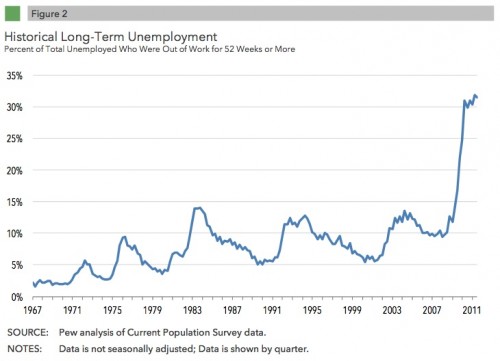Cross-posted at Family Inequality.
Americans about my age and older all seem to have stories about how we survived our school playgrounds without today’s cushy soft surfaces, safety-oriented climbing structures, and running water.
Here is a picture of the playground at my elementary school. I myself survived a fall off one of those seesaws onto the broken-glass-strewn asphalt, with nothing but a scrape to show for it (attended to by the school secretary — there was no “school nurse” back then either).

In the safety craze in recent decades, sadly, real seesaws were one of the first things to go.
Go back another few generations, and you’ll find stories like this — about 200 children killed in the streets of New York in 1910 (from the NYT Jan. 1, 1911):

Most of those kids weren’t in cars or wagons; they were playing in the streets, doing work for their families, or just wandering around unattended — there were no public playgrounds. In contrast, in 2009 there were about 10 pedestrian or cycling children killed by vehicles in New York City. Ah, the good old days.*
Nowadays
As things have gotten safer for America’s children, of course, parents have become ever more concerned with their safety, as well as with their learning and development. Somewhere in America on a Sunday a few weeks ago, in an affluent community, a public playground was bubbling with activity. Every child seemed to be enjoying a rollicking good time on the latest safety-designed play equipment, cushioned by a luxuriously deep bed of mulch.

Also, each child seemed to be within a few feet of a parent or other adult caretaker — coaching, encouraging, spotting, supervising.

In recent years, concern about the physical fitness of children has increased, especially among poor children. Some researchers have asked whether the proximity of safe neighborhood playgrounds is one cause of the social class disparity in obesity rates. That would make sense because obesity rates are lower among children who play outdoors. But the relationship between social class and playing outdoors is not clear at all. Rich children have more access to some kinds of facilities, but poor children have more free time — and, where there is public housing, it usually includes playgrounds, like this one photographed in the 1960s:

In Annette Lareau’s analysis of family life and social class, Unequal Childhoods, children of middle class and richer parents spend more time in organized activities, and poorer kids spend more time in unstructured time (including play and TV). But as these pictures show, there’s play and there’s play. Are middle class parents hovering more than poorer parents do, and with what effect?
Consider a recent article by Myron Floyd and colleagues (covered here), which attempted to assess the level of physical activity among children in public parks by observing 2,700 children in 20 public parks in Durham, NC:
[The] presence of parental supervision was the strongest negative correlate of children’s activity… the presence of adults appears to inadvertently suppress park-based physical activity in the current study, particularly among younger children… This result should be used to encourage park designers to create play environments conducive to feelings of safety and security that would encourage rather than discourage active park use among children. For example, blending natural landscapes, manufactured play structures, and fencing in close intimate settings can be used to create comfortable environments for children and families. Such design strategies could encourage parents to allow their children to freely explore their surroundings, providing more opportunities for physical activity.
Interestingly, park in the pictured above has a fence around it so that parents can hang around at a distance with little fear for their children.
Under social pressure
In Under Pressure, one of many books bemoaning the excesses of over-parenting, Carl Honoré wrote:
Even when we poke fun at overzealous parenting… part of us wonders, What if they’re right? What if I’m letting my children down by not parenting harder? Racked by guilt and terrified of doing the wrong thing, we end up copying the alpha parent in the playground.
The point is not just that some parents have overzealous supervisory ambitions, driven by unequal investments in children and a threateningly competitive future. I think there is a supervision ratchet that feeds on the interaction between parents. In an article called “Playground Panopticism,” Holly Blackford summarized her observations:
The mothers in the ring of park benches symbolize the suggestion of surveillance, which Foucault describes as the technology of disciplinary power under liberal ideals of governance. However, the panoptic force of the mothers around the suburban playground becomes a community that gazes at the children only to ultimately gaze at one another, seeing reflected in the children the parenting abilities of one another.
This plays out in everyday interaction, whether one wants to engage it or not. If everyone else’s kid is closely supervised while yours is running around bonkers on her own, what is a parent to do? If the other parents insist that their kids not go “up the slide” and yours just scrambles past them, you feel the pressure. (You also put the other parent in the position of violating another taboo — supervising someone else’s child.) So it’s not just fear of underparenting that drives parents to hover — it’s also the cross-parent interactions. These are the moments when contagious parenting behavior spreads.
—————————
*I started looking at this after reading about it in Viviana Zelizer’s Pricing the Priceless Child, in which she writes, “The case of children’s accidental death provides empirical evidence of the new meanings of child life in twentieth-century America.”
Reminder: This blog post does not constitute research, but rather commentary, observation and recommendations for reading and discussion. The description of my childhood playground, and of one recent afternoon at one park, are anecdotes, something that stimulates reflection on wider issues, not empirical evidence or data.
 This is a whimsical trailer for an animated movie with a progressive pro-environment message based on Dr. Seuss’ The Lorax. Pretty to watch, fantastical, heart-warming, and progressive… it draws you in and then, just as yoiur defenses had been lowered, BAM! It ends with a sexist joke.
This is a whimsical trailer for an animated movie with a progressive pro-environment message based on Dr. Seuss’ The Lorax. Pretty to watch, fantastical, heart-warming, and progressive… it draws you in and then, just as yoiur defenses had been lowered, BAM! It ends with a sexist joke.














